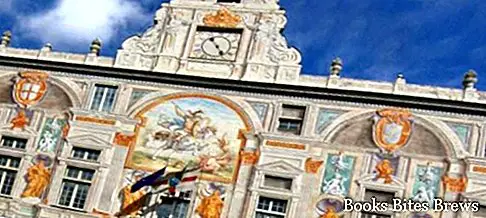What to see in Genoa, one-day walking itinerary to discover the main monuments and places of interest in the historic center, including the Palazzo San Giorgio and the Cathedral of San Lorenzo.
Tourist information
Capital of Liguria and important Italian port, Genoa is located close to the Apennine slopes, washed by the Ligurian Sea.
Although the origins of the city cannot be dated with certainty, some finds that have come to light testify that the first organized human settlements date back to a period between the ninth and sixth centuries BC, even if spontaneous agglomerations in the area probably already existed in eras previous, considering the geographical position in which the city is located, inside the inlet in the most sheltered point of the homonymous gulf.
Genoa, already in pre-Roman times at the center of important commercial traffic, was an ally of Rome and defined by the Romans as the "sea gate of the Po valley", with a significant role in the wars against the other Ligurian peoples enemy of the Romans and in the war against the Carthaginians.
After the fall of the Roman Empire, Genoa was destroyed several times, underwent various dominations, including the Byzantine, Ostrogoth, Lombard and Carolingian ones, and it was also subjected to Saracen invasions.
Between the eleventh and fifteenth centuries, the participation of Genoese ships in the first crusade allowed Genoa to significantly increase its importance from a political and mercantile point of view, becoming one of the most powerful maritime republics in the Mediterranean.
The Serenissima Republic of Genoa, called the Superba, Lady of the sea and owner of various possessions on the mainland, was such until 1815, when it was annexed to the Kingdom of Sardinia, except for the short period, less than a year, in which it was independent as the Ligurian Republic.
The history of Genoa is reflected in the various urban realities, of different ages and tastes, which characterize this city with a glorious past.
There are large and elegant buildings that overlook straight streets and narrow alleys called caruggi, which wind through the charming old town.
What see
Palazzo San Giorgio dates back to the medieval period, the ancient seat of the famous Banco San Giorgio, the cathedral of San Lorenzo, consecrated in 1118 and the main medieval city monument, the church of San Matteo, in Romanesque-Gothic style overlooking the square of the same name and surrounded from the houses of the Dorias, it offers an enchanting glimpse of the ancient city.
The Palazzo Ducale, the first nucleus of medieval origin, was incorporated into the subsequent construction, which began from the end of the sixteenth century.
Recommended readings- San Remo (Liguria): what to see
- Liguria: Sunday day trips
- Gallinara (Liguria): what to see on the island
- Noli (Liguria): what to see
- La Spezia (Liguria): what to see
From the towers of Porta Soprana, one of the access gates to the city, a walkable walkway starts, called the walls of Barbarossa, a work built by the Genoese population in 1155 to defend themselves from the invasion of Emperor Frederick I of Swabia, called the Barbarossa.
Continuing in the historic center of Genoa, a set of large and prestigious residential buildings, dating back to the period between the end of the sixteenth and the beginning of the seventeenth century, in Renaissance and Baroque style, arise along the ancient Strade Nuove, corresponding to the current streets Garibaldi, via Cairoli and via Balbi.
These excellent residences belonging to the nobility were inscribed in the Rolli, that is to say lists in which the palaces were cataloged and intended to host people on a state visit.
In the dispositions of the Rolli, according to the prestige of the dwelling, it was specified which characters should be destined, that is, taking into account whether it was Pope, Cardinal, Emperor, king or prince.
In later periods, these houses hosted illustrious travelers who left evidence of them in their stories.
The Strade Nuove and the complex of the Palazzi dei Rolli have been included in the UNESCO World Heritage Sites.
Walking along the Corso Italia seafront, you arrive in Boccadasse, the ancient fishing village dominated by the Church of Sant'Antonio di Boccadasse.
The village takes its name from the shape of the inlet where it stands, which seen from above looks like a mouth of a donkey, a mouth of donkey in Genoese.
On the promontory of San Benigno there is the Lanterna, the lighthouse of the port of Genoa, considered a symbol for the city.
Do not forget the famous aquarium of Genoa.




